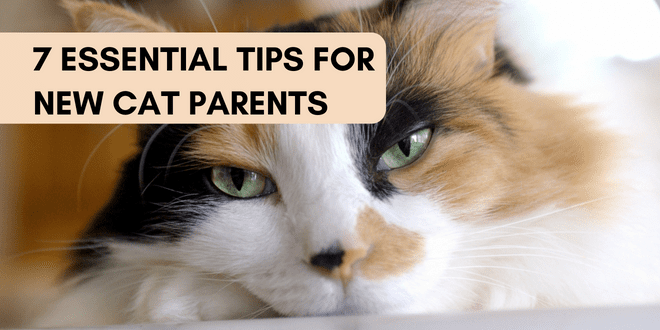
[ad_1]

Whether you’re a seasoned cat parent or a fresh recruit to the wonderful world of felines, there are things you need to know to help ensure your furry family member has a happy, healthy life. While there certainly is much more cat wisdom you’ll still need, here’s a rundown of the top seven cat commandments to get you started.
1. Veterinary Care
Regular veterinary care is crucial to your cat’s lifetime health. Stay on schedule with annual exams to monitor overall health, stay up-to-date with vaccinations, and maintain dental hygiene. Cats are pros at hiding pain and very often, the only indication of potential illness or pain may be a change in typical behavior, appetite, or litter box usage. If you notice any change in your cat’s typical routine, appearance, or overall behavior, consult your veterinarian.
Don’t skip annual wellness visits just because your cat appears healthy. It’s during those yearly routine visits that a problem may be detected in its early stage and that could reduce suffering as well as increase the chances of successful treatment.
Regardless of whether you plan on keeping your cat exclusively indoors or not, spaying and neutering is essential. In addition to preventing unwanted litters, it reduces the risk of certain cancers and other health issues. With male cats, if left intact, you will, at some point deal with spray-marking. Talk with your veterinarian if you have any questions or concerns about the spay or neuter procedure.
2. Proper Nutrition and Hydration
Cats are obligate carnivores and even though they can sometimes seem like furry food critics, their diet must include adequate protein from animal sources. Whether it’s commercial cat food, a raw diet, or your special homemade recipe, make sure it’s top-notch to meet your cat’s needs to maintain optimal health. A common mistake some cat parents make is to over-feed. The instructions on the container of food is just a general guideline. Determine the correct portion based on your cat’s age, health, body type, and activity level. If you have questions about how much to feed, consult your veterinarian.
Although dry food is certainly very convenient, wet food is closer to what a cat would naturally eat and will provide more moisture. Dry food may contribute to urinary tract issues.
Proper hydration is also essential. Provide access to clean, fresh water daily. Cats fed dry food will need to drink more because the food only contains about 10% moisture. Cats fed wet food may drink less but it’s still important to always have fresh water available. Wash the water bowl out daily to prevent the build-up of biofilm. If you’re concerned that your cat isn’t drinking enough water, try different style bowls to decrease any whisker discomfort. Adding a pet water fountain may also help. Talk to your veterinarian if you have concerns about your cat’s hydration levels.
3. Litter Box Set-up and Maintenance
Provide your cat with the Cadillac of litter boxes. All cats deserve that! For maximum comfort, the box should be 1 ½ times the length of your cat from tip of the nose to base of the tail. If you’re unable to find a box that’s big enough, create a custom-size one by using a plastic storage container.
That Cadillac of litter boxes should also be a convertible model. Purchase an uncovered box to prevent your cat from feeling cramped while in there. An open box will also allow the litter to dry more efficiently. Uncovered boxes provide escape potential and that’s an important feature when a cat is in the vulnerable position of being in the litter box. Being uncovered will additionally make it easier for you to notice when the box needs scooping. If you’re concerned about litter scatter, choose a high-sided plastic storage container and cut a “U” shaped entrance on one end for your cat to easily enter and exit
Maintain a good scooping schedule by checking and scooping the litter box at least twice a day. Completely wash the box at least monthly if using scoopable litter and more frequently if using non-scoopable. Speaking of litter, choose unscented out of respect for your cat’s very sensitive nose.
The general rule is to have one litter box per cat but one extra to ensure there are enough options for everyone. In a multicat household, don’t line the litter boxes up in one area. Boxes should be spread out to allow for personal territories and so a cat doesn’t have to cross into another cat’s area to locate an elimination spot.
Place litter boxes in quiet areas that are out of the way of family traffic, but don’t locate them so remotely that they’re inconvenient. Don’t place boxes up against corners, in cabinets, or under furniture. Remember, escape potential is a top priority in the cat world when in vulnerable situations.
Avoid sudden changes in litter brands or types as cats are sensitive to abrupt change. Make slow transitions or, if you aren’t sure which litter your cat will like, set out a litter box buffet and let your cat decide.
4. The Need for Claws
Cats have a natural need to scratch. This aspect of cat life is vital to physical and mental health. Scratching maintains nail health, is a way the cat stretches, is a marking behavior, and is also beneficial for emotional displacement.
Provide a tall, sturdy scratching post covered in a claw-appealing material such as sisal. Place the scratching post where your cat likes to scratch. Invest in more than one scratching post if you have a multicat household or if your cat likes to scratch in multiple areas. Many prefer to scratch near entryways, or other social significant areas of the home.
Horizontal scratching pads can be used if your cat prefers that scratching position. Corrugated cardboard scratching pads come in many sizes and shapes and are an inexpensive way to provide the variety many cats enjoy when it comes to scratching behavior.
Don’t declaw your cat. Fortunately, it’s becoming banned in more locations because of the awareness of the painful recovery, long-term physical and emotional effects, and how necessary claws are for a cat’s overall health. Learn to trim your cat’s claws using positive, gentle techniques, such as clicker training. If you are unsure about claw trimming, have your veterinarian or a veterinary technician instruct you on the procedure. With patience, tenderness, and a few yummy treats, you can train your cat.
5. Enrichment and Mental Stimulation
Cats are intelligent, curious, and as hunters, they’re hardwired to seek and discover. Provide appropriate toys, scratching posts, a variety of perches and elevated locations (such as a cat tree), as well as hiding places to satisfy the natural instinct to climb, jump, play, scratch, and hide.
Playtime should include opportunities for solo play with interesting and fun toys as well as interactive playtime. Interactive play is where you are an integral participant in that you’ll use a fishing pole type toy to entice your cat’s play drive. Use the toy to mimic the movements of prey to satisfy your cat’s natural hunting passion. Interactive play is beneficial for your cat’s physical and mental health as well as being important for building trust and strengthening the human/cat bond. For safety, put all interactive toys away after the playtime session to prevent your cat from getting tangled in any strings and to prevent the risk of choking.
For solo playtime, scatter toys in strategic locations for your cat to discover. Don’t just heap the toys into a basket in the corner because then they just become lifeless prey. Be mindful of how you position them. Something like a fuzzy mouse inside an open paper bag or cardboard box can be very enticing.
Include puzzle feeders to help prevent boredom, ease stress, and to help with mealtime issues. A puzzle feeder is a toy that contains food or treats, and your cat must move or manipulate it in some way to retrieve the food reward. Puzzle feeders are great for cats who eat too quickly. Search online and you’ll find many options for puzzle feeders.
You don’t need to break the budget to supply toys for your cat. Rotate toys to re-ignite interest. Catnip or silver vine can also be used for added enticement.
6. Socialize and Train Your Cat
Invest the time in helping your cat become comfortable with normal aspects of cat life such as being in a carrier, car travel, being handled (important for medicating and nail trims), being comfortable with visitors in the home, being brushed, and so on. The way to do it is to keep each experience positive and do it gradually. Use treats to reward your cat for even the smallest of baby steps. You can find lots of information on our website with training techniques for each.
7. Pay Attention to Your Cat’s Body Language
To build a strong bond and maintain trust with your cat, you’ll need to understand body language. Cats communicate very efficiently through body signals, and being able to interpret those cues can help you respect preferences and that can go a long way in avoiding being scratched or bitten. Pay attention to how your cat is positioned, tail position, ear orientation, facial expression, and pupil size. Take the immediate environment into consideration as well when gauging what your cat may be communicating. Be mindful of shifts in mood as well. Your cat may enjoy being held by you for only a certain amount of time or may prefer being petted around the head and not along the spine. Respect preferences and adapt to changes in mood.
Respect your cat’s need for personal space and boundaries. Your cat may enjoy snuggling with you at times but may also need some solitude. Learn to identify when your cat is requesting an increase in distance.
Life with a cat is a rewarding and loving but it’s essential you do your part by having the knowledge and appreciation of their needs and nature. By ensuring top nutrition, regular veterinary care, mental stimulation, playtime, appealing and clean litter box set-up, appropriate scratching locations, and an understanding of feline body language, you’re on your way to building a loving and healthy relationship.
So, that’s your crash course in Cat Care 101. This is just the beginning though. Learn, observe, train with love, and be an advocate for your cat.
Need More Information?
If you have questions about your cat’s health or nutrition, consult your veterinarian. For more information on cat behavior and training, refer to the best-selling books by Pam Johnson-Bennett. Pam’s books are available at bookstores and online. We’ve included links to Amazon here on our website.
[ad_2]










